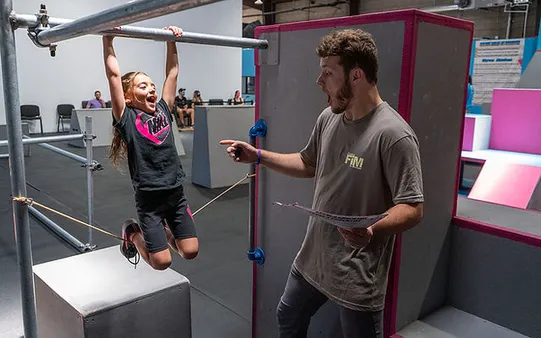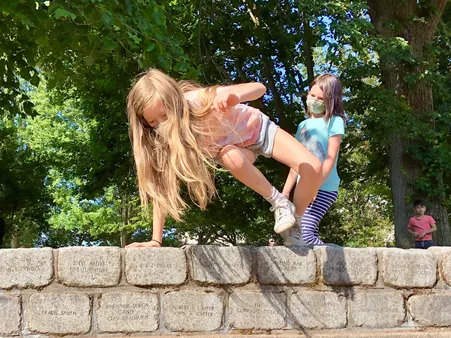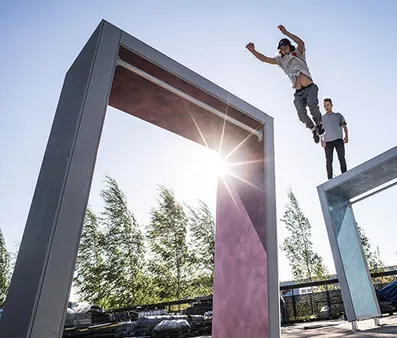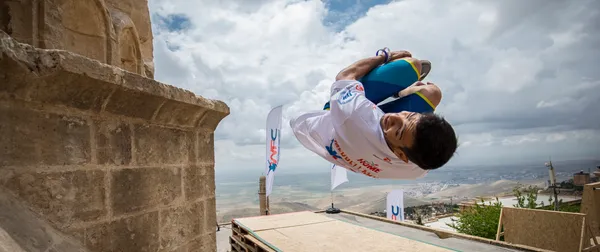Table of Contents
Have you ever watched someone effortlessly scale a wall, leap over a gap, or gracefully flow through an urban environment? If so, you've witnessed the incredible art of Parkour. Parkour, also known as freerunning, is a discipline that involves overcoming obstacles by using movement. It is a physically and mentally challenging activity that can be enjoyed by people of all ages and fitness levels. Whether you're looking to improve your fitness, coordination, or confidence, or you're simply looking for a new and exciting way to challenge yourself, parkour may be the perfect activity for you. At Kizworld, we're passionate about parkour and we're here to provide you with all the information you need to get started.
Parkour: The Art of Movement and Overcoming Obstacles
I. Different Types of Parkour
Different Types of Parkour
Parkour is a discipline that involves overcoming obstacles by using movement. It is a physically and mentally challenging activity that can be enjoyed by people of all ages and fitness levels. There are many different types of parkour, each with its own unique set of challenges and rewards. Some of the most popular types of parkour include:
- Freerunning: Freerunning is a type of parkour that emphasizes creativity and fluidity of movement. Freerunners use their environment to create their own unique lines and tricks, often incorporating flips, spins, and other acrobatic maneuvers.
- Speedrun: Speedrun is a type of parkour that emphasizes speed and efficiency. Speedrunners try to complete a course as quickly as possible, using the most direct and efficient routes. Speedrun is often used in competitions, where athletes compete to see who can complete a course in the fastest time.
- Tricking: Tricking is a type of parkour that emphasizes technical skill and precision. Trickers perform a variety of flips, spins, and other acrobatic maneuvers, often in combination with each other. Tricking is often used in competitions, where athletes compete to see who can perform the most difficult and impressive tricks.
No matter what type of parkour you choose to practice, there are many benefits to be gained. Parkour can help you improve your fitness, coordination, and balance. It can also help you develop your mental strength and resilience. And perhaps most importantly, parkour can be a lot of fun!
Physical Benefits | Mental Benefits |
Improved fitness | Increased confidence |
Improved coordination | Improved focus |
Improved balance | Increased creativity |
Reduced stress | Improved problem-solving skills |
Increased energy levels | Increased sense of accomplishment |
If you're interested in trying parkour, there are a few things you should keep in mind. First, it's important to start slowly and gradually increase the difficulty of your training. Second, it's important to listen to your body and take breaks when you need them. And third, it's important to find a qualified instructor who can help you learn the basics of parkour safely and effectively.
With a little effort and dedication, you can learn to overcome obstacles and achieve your parkour goals. So what are you waiting for? Get started today!
Here are some additional tips for getting started with parkour:
- Find a qualified instructor. A qualified instructor can help you learn the basics of parkour safely and effectively.
- Start slowly and gradually increase the difficulty of your training. Don't try to do too much too soon, or you'll risk getting injured.
- Listen to your body and take breaks when you need them. It's important to avoid overtraining, which can lead to injuries.
- Have fun! Parkour is a challenging but rewarding activity. Enjoy the process of learning and improving your skills.
If you're looking for a fun and challenging way to get in shape, parkour is a great option. With a little effort and dedication, you can learn to overcome obstacles and achieve your parkour goals.
So what are you waiting for? Get started today!
Here are some related articles that you may find helpful:
- How to Overcome Obstacles and Challenges with Parkour
- The Benefits of Parkour for Physical and Mental Development
- The Best Parkour Equipment and Gear
II. Progression in Parkour
Progression in Parkour
Parkour involves different levels of progression that enable practitioners to enhance their skills gradually. It begins from basic movements and progresses to advanced techniques as an individual's confidence and proficiencies increase. These levels allow practitioners to build a solid foundation and a systematic approach to learning parkour.
The initial phase of parkour progression involves fundamental movements such as vaults, rolls, and wall runs. These basic movements are the building blocks for more complex techniques and help in developing coordination, strength, and body awareness. As individuals master these basics, they can progress to intermediate moves, including precision jumps, cat leaps, and kong vaults. These maneuvers require greater control and technical skills, and they push practitioners to think creatively and overcome new challenges.
Level | Skills |
Beginner | - Vaults- Rolls- Wall runs- Simple jumps |
Intermediate | - Precision jumps- Cat leaps- Kong vaults- Tic-tacs |
Advanced | - Flips- Spins- Wallflips- Twists |
As proficiency in parkour develops, practitioners can advance to higher levels of difficulty. Advanced techniques like flips, spins, wallflips, and twists demand immense physical strength, flexibility, and the ability to control movements precisely. These advanced maneuvers are the hallmark of experienced parkour athletes and demonstrate their mastery over the discipline.
Progression in parkour is a continuous process that requires dedication, perseverance, and a willingness to push boundaries. Each level presents unique challenges, but by breaking down the learning process into digestible steps, practitioners can overcome obstacles, master new techniques, and elevate their parkour skills to new heights.
- Read more about the benefits of parkour for physical and mental development.
- Learn the basic parkour skills and movements.
III. Benefits of Doing Parkour
Benefits of Doing Parkour
Parkour offers a wide range of benefits for both physical and mental health. Here are some of the key benefits of practicing parkour:
- Improved Physical Fitness: Parkour is a physically demanding activity that requires strength, agility, and endurance. It helps to improve cardiovascular health, muscular strength, and flexibility.
- Enhanced Coordination and Balance: Parkour requires precise movements and coordination to navigate obstacles. It helps to improve hand-eye coordination, balance, and proprioception.
- Increased Confidence and Self-Esteem: Overcoming obstacles and challenges in parkour can boost confidence and self-esteem. It teaches individuals to believe in their abilities and to push their limits.
- Stress Relief and Mental Well-being: Parkour can be a great way to relieve stress and improve mental well-being. The physical exertion and focus required during parkour can help to clear the mind and reduce anxiety.
- Social Interaction and Community: Parkour is often practiced in groups, which can foster social interaction and a sense of community. It provides an opportunity to connect with like-minded individuals and to learn from each other.
In addition to these benefits, parkour can also be a lot of fun and a great way to stay active and healthy. It is a challenging and rewarding activity that can be enjoyed by people of all ages and fitness levels.
If you are interested in trying parkour, there are a few things you should keep in mind. First, it is important to start slowly and gradually increase the difficulty of the obstacles you attempt. Second, it is important to wear proper safety gear, such as a helmet and knee pads. Third, it is important to find a qualified instructor who can teach you the basics of parkour and help you to progress safely.
With a little practice, you can start to enjoy the many benefits that parkour has to offer. So what are you waiting for? Get out there and start training!
Here are some additional tips for getting started with parkour:
- Find a qualified instructor: A qualified instructor can teach you the basics of parkour and help you to progress safely. Look for an instructor who is certified by a reputable organization, such as the American Parkour Association (APA) or the World Freerunning Parkour Federation (WFPF).
- Start slowly: Don't try to do too much too soon. Start with simple obstacles and gradually increase the difficulty as you get more comfortable.
- Wear proper safety gear: Always wear a helmet and knee pads when practicing parkour. You may also want to wear elbow pads, wrist guards, and shin guards.
- Be patient: Parkour takes time and practice to learn. Don't get discouraged if you don't see results immediately. Just keep practicing and you will eventually reach your goals.
- Have fun: Parkour is a challenging but rewarding activity. Make sure to have fun while you're training!
If you are looking for a fun and challenging way to get in shape, parkour is a great option. With a little practice, you can start to enjoy the many benefits that parkour has to offer.
Check out our related posts on How to Overcome Obstacles and Challenges with Parkour and The Benefits of Parkour for Physical and Mental Development to learn more.
IV. Parkour Training
Parkour Training
Parkour training is essential for developing the skills and abilities needed to safely and effectively navigate urban environments. It involves a combination of physical conditioning, technique practice, and mental preparation.
Physical conditioning is the foundation of parkour training. It includes exercises to improve strength, flexibility, agility, and endurance. Strength training helps to build the muscles needed to perform parkour moves, such as vaults, jumps, and wall climbs. Flexibility training helps to improve range of motion and reduce the risk of injury. Agility training helps to improve coordination and balance. Endurance training helps to improve stamina and the ability to perform parkour moves for extended periods of time.
- Strength training: This includes exercises such as push-ups, pull-ups, squats, and lunges.
- Flexibility training: This includes exercises such as stretching, yoga, and Pilates.
- Agility training: This includes exercises such as plyometrics, cone drills, and ladder drills.
- Endurance training: This includes exercises such as running, swimming, and biking.
Technique practice is another important aspect of parkour training. This involves learning and practicing the basic movements of parkour, such as vaults, jumps, wall climbs, and rolls. It also involves learning how to combine these movements into fluid and efficient sequences.
Mental preparation is also important for parkour training. This involves developing the confidence and focus needed to safely and effectively navigate urban environments. It also involves learning how to assess risks and make quick decisions.
Parkour training can be challenging, but it is also very rewarding. It is a great way to improve your fitness, learn new skills, and challenge yourself. If you are interested in learning parkour, there are many resources available to help you get started.
Here are some tips for getting started with parkour training:
- Find a qualified instructor. A qualified instructor can help you learn the basics of parkour safely and effectively.
- Start slowly. Don't try to learn too much too quickly. Focus on learning the basics first and then gradually progress to more advanced moves.
- Be patient. It takes time to learn parkour. Don't get discouraged if you don't see results immediately. Just keep practicing and you will eventually reach your goals.
- Have fun! Parkour is a great way to get exercise, learn new skills, and challenge yourself. So relax, have fun, and enjoy the journey.
If you are looking for a challenging and rewarding way to improve your fitness, learn new skills, and challenge yourself, then parkour may be the right activity for you. With a little dedication and effort, you can learn to overcome obstacles and navigate urban environments with ease.
Here are some related articles that you may find helpful:
V. Conclusion
Parkour is a challenging and rewarding activity that can be enjoyed by people of all ages and fitness levels. It is a great way to improve your fitness, coordination, and confidence. It can also be a lot of fun! If you're looking for a new and exciting way to challenge yourself, parkour may be the perfect activity for you. So what are you waiting for? Get out there and start moving!